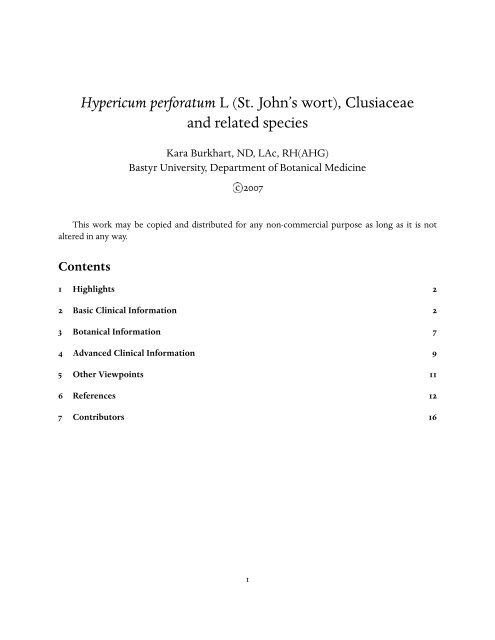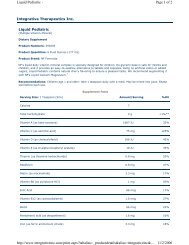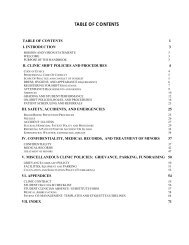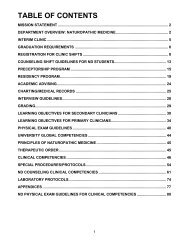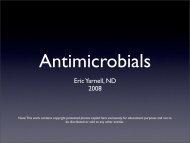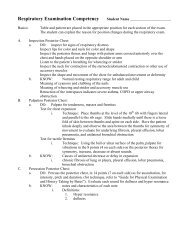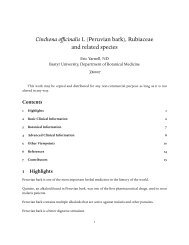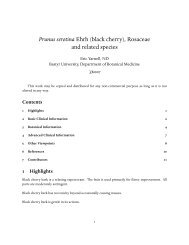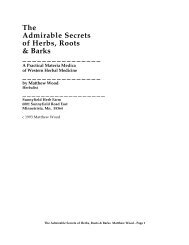Hypericum perforatum L (St. John's wort ... - AaronsWorld.com
Hypericum perforatum L (St. John's wort ... - AaronsWorld.com
Hypericum perforatum L (St. John's wort ... - AaronsWorld.com
- No tags were found...
You also want an ePaper? Increase the reach of your titles
YUMPU automatically turns print PDFs into web optimized ePapers that Google loves.
<strong>Hypericum</strong> <strong>perforatum</strong> L (<strong>St</strong>. John’s <strong>wort</strong>), Clusiaceaeand related speciesKara Burkhart, ND, LAc, RH(AHG)Bastyr University, Department of Botanical Medicinec2007This work may be copied and distributed for any non-<strong>com</strong>mercial purpose as long as it is notaltered in any way.Contents1 Highlights 22 Basic Clinical Information 23 Botanical Information 74 Advanced Clinical Information 95 Other Viewpoints 116 References 127 Contributors 161
1 Highlights<strong>St</strong> Johns <strong>wort</strong>, one of the bestselling herbal medicines worldwide, is a very popular treatment formild-to-moderate depression in Europe and North America.Research indicates that <strong>St</strong>. John’s <strong>wort</strong>’s antidepressive action is multifaceted with inhibition of thereuptake of serotonin (SSRI action), inhibition of reuptake of noradrenaline, activation of gammaaminobutyrate(GABA) and glutamate receptors, and alteration of the hypothalamic-pituitary-adrenal(HPA) axis (Lawvere and Mahoney 2005).The medicinal actions of <strong>Hypericum</strong> are related to a number of <strong>com</strong>pounds as opposed to one activeconstituent, particularly hypericins, hyperforin, and flavonoids.It may take 2-6 weeks to observe the full clinical benefit of taking <strong>Hypericum</strong>. Blood levels of keyconstituents have been demonstrated to continually rise over a few weeks.<strong>Hypericum</strong> is associated with lower levels of side effects when <strong>com</strong>pared to tricyclic antidepressantsand MAO inhibitors. <strong>Hypericum</strong> does not induce cardiac or anticholinergic side effects (David 2000).<strong>St</strong>. John’s <strong>wort</strong> induces CYP3A4 in the intestines. This is the most <strong>com</strong>mon enzyme responsible forbreaking down drugs, so multiple potentially serious interactions (loss of drug activity) can occur.2 Basic Clinical Information2.1 Part UsedLeaf and flower, fresh or dried.2.2 TasteFloral2.3 Principal Actions Nervine Antidepressent (mild-to-moderate) (Schüle, et al. 2001) Anxiolytic (Singewald, et al. 2004) Antimicrobial, particularly antiherpetic (Someya 1985; Lavie 1987) and anti-HIV (Degar, et al.1992; Xu and Lu 2005) Vulnerary (Mukherjee, et al. 2000)2
2.4 Major Organ System AffinitiesNervous systemImmune system2.5 Major Indications Major depressive disorder, mild-to-moderate Seasonal affective disorder (Wheatley 1999; Kasper 1997; Martinez, et al. 1994) Anxiety disorder (Muller, et al. 2004) Nervous tension Sleep disorders/insomnia (Schulz and Jobert 1994) Wounds (topical) (Kiriluk 1978) Herpes infections (topical)Meta-analyses of the clinical trials of <strong>St</strong>. John’s <strong>wort</strong> standardized extracts shows that it is consistentlymore effective than placebo and similarly to slightly less effective than tricyclic and selectiveserotonin reuptake inhibitor (SSRI) antidepressants for patients with mild-to-moderate major depression(Linde, et al. 2005a; Linde, et al. 2005b; Gaster and Holroyd 2000). <strong>St</strong>. John’s <strong>wort</strong> extracts werealso significantly safer than tricyclic antidepressants and marginally safer than SSRIs as measured bydrop-out rates. In patients with severe major depression, <strong>St</strong>. John’s <strong>wort</strong> extracts were only marginallyeffective. There is some evidence that patients with depression who respond within the first two weeksof treatment with <strong>St</strong>. John’s <strong>wort</strong> are most likely to have sustained, significant responses (Kieser andSzegedi 2005).<strong>St</strong>. John’s <strong>wort</strong> standardized extract was not effective in a small placebo-controlled trial for peoplewith social phobia (Kobak, et al. 2005).2.6 Major Constituents Naphthodianthrones (hypericin, pseudohypericin) Phloroglucinols (hyperforin) Flavonoids, epicatechin2.7 Energetics<strong>St</strong> Johns <strong>wort</strong> is said to protect the home against harm and loss and has a long history of use in magicalcharms (de Bairacli Levy 1997).2.8 Preparations and DoseTincture: 1:2–1:5, 40-60% ethanol, macerated in direct sunlight. Tincture can also be applied topicallyto herpes lesions which is doubly soothing as the ethanol dries out the lesions which brings someimmediate relief. However, this does tend to stain the lesions a redder color.3
Tea:Tincture Doses:Acute, adult: 4-5 ml every 2-3 h, adjusted for body size (not clearly useful acutely)Chronic, adult: 2-5 ml tid adjusted for body sizeChild: as adult but adjusted for body sizeTea DosesChronic, adult: 2-4 grams of dried herb per cup boiling water, infuse 10-15 minutes, drink threetimes dailyChild: as adult but adjusted for body size<strong>St</strong>andardized extract (containing 0.3% hypericin or 3% hyperforin): 450 mg twice daily or 300 mg threetimes per day for chronic adult dosing. Doses up to 1,500 mg daily have been used safely in clinicaltrials but generally do not show superior results.Infused Oil: Apply topically several times a day to minor wounds or burns. Do not apply topically toherpes lesions as the carrier oil tends to spread the rash.Cream or ointment: Apply topically several times a day to minor wounds or burns. Ointments shouldnot be applied to herpes lesions but creams can be applied in most cases.2.9 Adverse Effects Dry mouth Dizziness Gastrointestinal upset Fatigue Headache Sexual dysfunction Photosensitivity skin rash AnxietyAll the listed effects are rare or very rare.In healthy adult men, three extracts with different hypericin contents were shown, after 14 d treatment,to overall not increase the minimal erythema dose (MED) after exposure to UV light (Schulz,et al. 2006). However, some individuals did show signs of increased sensitivity to light, and two reportedmild photosentivity reactions to low intensity light. In a double-blind trial, 13 healthy adultstook single doses a <strong>St</strong>. John’s <strong>wort</strong> extract orally providing 0, 2.8, 5.6, or 11.25 mg total hypericin andpseudohypericin and then tested for photosensitivity for 68 h afterward (Brockmoller, et al. 1997).There was no sign of increasing photosensitivity with any dose <strong>com</strong>pared to placebo. An additional50 healthy adults took 600 mg of extract three times daily (providing 5.6 mg total hypericins) for 15d found a modest but significant decrease in the MED of approximately 20% <strong>com</strong>pared to placebo.4
Plasma hypericin levels above 100 mcg/L and ingestion of more than 11.25 mg total hypericins per dayare associated with the greatest risk of photosensitization. Similar results were found in a trial thatgave doses for 7 d (Schempp, et al. 2003; Schempp, et al. 2001).Topical application of <strong>St</strong>. John’s <strong>wort</strong> infused oil or ointment (with hpyericin contents of 110mcg/ml and 30 mcg/ml respectively) were tested in healthy, fair-skinned adults (Schempp, et al. 2000).While no change could be detected visually, a sensitive photometric device could show a significantdecrease in MED <strong>com</strong>pared to placebo. This suggests that these agents do not cause major photosensitizationbut in very susceptible individuals they could lead to trouble.Photosensitivity is associated with the naphthodianthrone derivitives hypericin and pseudohypericin,though good evidence suggests hypericin is the primary culprit (Vandenbogaerde, et al. 1998).<strong>Hypericum</strong> extracts are not irritant or immunologically sensitizing when applied topically (Anonymous2001).With pure intravenous hypericin, 0.5 mg/kg in fair-skinned patients developed pain and erythemawithin 5-10 minutes of sun exposure (direct or through glass), while darker-skinned patients tookweeks to develop photosenstivity (Gulick, et al. 1992). Photosensitivity develops in a majority ofpatients given just 0.05 mg/kg hypericin intravenously (Jacobson, et al. 2001; Pitisuttithum, et al.1996).2.10 Contraindications Bipolar disorder Mania Photosensitivity disorder or con<strong>com</strong>itant photosensitizing drug useData on effects in human pregnancy and lactation are sparse. The risk of postpartum depressionis considered greater than any risk of taking <strong>St</strong>. John’s <strong>wort</strong> while lactating, however.In a case-control study, 33 lactating women who were taking <strong>St</strong>. John’s <strong>wort</strong> extracts were <strong>com</strong>paredwith 101 matched controls not taking <strong>St</strong>. John’s <strong>wort</strong> (Lee, et al. 2003). There was a statisticallysignificant but clinically slight increase in adverse effects in infants whose mothers took <strong>St</strong>. John’s<strong>wort</strong>–2 instances of colic vs. 1, 2 instances of drowsiness vs. none, and 1 instance of lethargy vs. nonein the hypericum vs. control groups respectively. No treatment was considered necessary to remedyany of these events, so clearly they were all quite minor. Hyperforin is excreted in breast milk ofwomen who take <strong>St</strong>. John’s <strong>wort</strong> extracts and does occur in their breast-fed infants’ serum at levelssimilar to that seen after direct oral feeding, though this is not associated with any obvious adverseeffects (Klier, et al. 2006).Most studies in rodents have not found any harm to the fetus when <strong>St</strong>. John’s <strong>wort</strong> extract wasgiven during gestation (Borges, et al. 2005; Rayburn, et al. 2001; Rayburn, et al. 2000). One studyfound that very high doses, far beyond usual human doses, could lead to reduced gestational weight,but otherwise had no negative effects on neurobehavioral development (Cada, et al. 2001). One studyfound that continuous exposure of maternal rats to either 100 mg/kg or 1,000 mg/kg (the latter 10times higher than reasonable human doses) found microscopic liver and kidney damage in infants bornto and breast-fed by these rats (Gregoretti, et al. 2004). This report makes no mention of whether this5
was clinically relevant, ie, if the behavior or any other observable factors in the rats were changed bythese microscopic lesions (they do report no difference in maternal weight gain, infant birth weight,or number of pregnancies carried to term between the hypericum and control groups).It has been argued that <strong>St</strong>. John’s <strong>wort</strong> toxicity, even taking into account the potential for adversedrug interactions, is tenfold less than that of prescription antidepressants when <strong>com</strong>paring clinicaltrials (Schulz 2006).2.11 OverdoseAcute overdose is not generally associated with anything more severe than nausea and vomiting.Chornic overdose can lead to photosensitivity in some people.2.12 In<strong>com</strong>patibilitiesNone clearly identified.2.13 Adverse Drug Interactions<strong>Hypericum</strong> is known to induce intestinal CYP3A4 and P-glycoprotein. This leads to increased catabolismand reduced absorption of medications that are CYP3A4 substrates. Hyperforin appears to be a criticalmediator of these effects, as low-hyperforin extracts have not been shown in humans to affect drugmetabolism (Arold, et al. 2005). <strong>St</strong>. John’s <strong>wort</strong> does not interfere with protein binding of drugs (Smith2004). People of European descent appear more sensitive to the effects of <strong>St</strong>. John’s <strong>wort</strong> on 3A4 thanIndians, Chinese, or Hispanics (Xie, et al. 2005).Drugs of Which <strong>Hypericum</strong> Lowers Blood Levels (Lawvere 2006)Oral contraceptives (Schwarz, et al. 2003)AmitriptylineCyclosporineDigoxin (Johne, et al. 1999)Imatinib (Smith 2004)Indinavir (and probably all other protease inhibitors) (Piscitelli, et al. 2000)Irinotecan (Mathijssen, et al. 2002)MidazolamNevirapinePhenprocoumon (Maurer, et al. 1999)SertralineSimvastatinTacrolimus (Mai, et al. 2003)Theophylline (Nebel, et al. 1999)Warfarin (Jiang, et al. 2004; Yue, et al. 2000)Due to the theoretic possibility of developing serotonin syndrome, and a small handful of lowqualitycase reports suggesting this can occur (Gordon 1993; Beckman, et al. 2000), the use of <strong>St</strong>.John’s <strong>wort</strong> in conjunction with SSRI antidepressants requires close monitoring.6
3 Botanical Information3.1 Common NamesEnglish Common Names: <strong>St</strong> Johns <strong>wort</strong>, <strong>St</strong>. Joans <strong>wort</strong>, Klamath weedChinese Common Names: tian ji huangFinnish Common Names: Mäkikuisma, LäpikuismaGerman Common Names: JohanniskrautItalian Common Names: ipericoSwedish Common Names: Äkta mannablod, Äkta Johannesört3.2 Botanical DescriptionPerennial herb that is usually erect with multiple branching distally. The stems have black or redglands on raised vertical lines. Leaves are oblong to elliptic or linear with pale or sometimes blacklaminar glands. Flowers July–August. The inflorescence appears in one to three nodes, with floweringbranches of whole cylindrical to broadly pyramidal or flat topped golden yellow flowers. The fruit isa capsule (Robson 2003).Botany SummaryForm: perennial herb up to 2.5 m tallFlowersInflorescence: branching cymesCalyx: sepals connate at base, half the length of petalsCorolla: five petals, black glands at marginsAndroecium: multiple prominent stamens in bundles of threeGynoecium: three stylesOvary: superior, three chamberedLeaves: ovate-linear, opposite, sessile, contains translucent dark glands<strong>St</strong>em: woody at base of older plants, herbacious above, up to 30 stems per adult plantFruit: capsule with three cellsSeeds: tiny brown or black, 400-500 per capsule. Can form either from insect pollination orapomixis (development without pollen).Roots: taproot up to 3 m deep, lateral roots usually only a few cm long but can reach 1 m7
H. <strong>perforatum</strong> by the National Geographic Society. H. <strong>perforatum</strong>3.3 Interchangeability of SpeciesThere are many other species in this genus, though it is unclear if they are interchangeable. Many donot produce hypericins. If the plant does not turn the fingers red or purple when bruised, then assumeit is not medicinal.3.4 Native Habitat and Current RangeThe genus <strong>Hypericum</strong> occurs in all temperate regions of the world. It is thought that <strong>Hypericum</strong> <strong>perforatum</strong>most likely first appeared in Siberia (Robson 2003). It is now an invasive weed in various partsof North America, so much so that it cannot be legally planted in some jurisdictions (eg California,Washington). <strong>St</strong>. John’s <strong>wort</strong> was introduced to the US intentionally in 1696 and reached the west by1893.3.5 Ecological <strong>St</strong>atus and Alternatives<strong>Hypericum</strong> <strong>perforatum</strong> is not ecologically challenged. Rather, it is an invasive pest in North America.In 1945, biological control was first attempted when Chrysolina quadrigemina (flea beetle) from Europewas introduced in California. This dramatically reduced the <strong>St</strong>. John’s <strong>wort</strong> population by 99%. Three8
other biological controls, Chrysolina hyperici, which also eats the leaves like the flea bettle, Aploceraplagiata(moth that eats leaves and flowers), and Agrilus hyperici (beetle that eats the root).3.6 CultivationVery easy with a strong tendency to invasive weediness. Spreads by runners and seeds (5-28 d germination).<strong>St</strong>ratification speeds germination. Requires only marginal soil, good draining and full sun.Plants should not be harvested until the second year of growth for optimal constituent development.3.7 WildcraftingHarvesting should be extensive in the US to help decrease the invasive nature of this plant in thisnon-native habitat. Do not protect stands—harvest it out <strong>com</strong>pletely so that native plants can regrow.There are no potentially-dangerous look-alikes.4 Advanced Clinical Information4.1 Additional Actions Antimicrobial Anti-inflammatory Vulnerary Astringent Antioxidant Anti-tumorHypersecretion of adrenocorticotropic hormone (ACTH) and cortisol have been linked to individualswho suffer from major depression. It is postulated and demonstrated in rat studies that <strong>Hypericum</strong>flavonoids alter expression of genes involved in regulation of the HPA axis.(Butterweck, 2004)4.2 Additional Indications Obsessive-<strong>com</strong>pulsive disorder (Taylor and Kobak 2000) Attention deficit/hyperactivity disorder Postpartum depression Menopausal symptoms (Uebelhack, et al. 2006) Dysthymia (negative study, Randlov, et al. 2006) Topically for burns, especially sunburn. Topically to decrease nerve pain incluing postherpetic neuralgia and trigeminal neuralgia. Internally as an antiviral for herpes infection.9
4.3 ConstituentsA crushed <strong>Hypericum</strong> flower produces a burgundy substance. Hypericin and pseudohypericine aremostly responsible for the burgundy color of oil infused with flowering tops of <strong>Hypericum</strong>. Volatileoil, containing caryophyllene, methyl-2-octane, n-nonane, n-octanal, n-decanal, [[alpha]]- and [[beta]]-pinene, and traces of limonene and myrcene.OHOOHHOCH 3OOHHOCH 3OOOHOHypericinOHHyperforin4.4 PharmacokineticsIn a clinical trial of 18 healthy adult men, a standardized extract of <strong>St</strong>. John’s <strong>wort</strong> was shown to havethe following pharmacokinetic properties (after 14 d of use):Constituent C max , ng/ml t max , h Elimination t 1/2 , hHyperforin 83.5 4.4 19.6Hypericin 3.14 8.1 23.8Isorhamnetin 1st peak 7.6 1.5 4.5Isorhamnetin 2nd peak 9 6.4 4.5Pseudohypericin 8.5 3 25.4Quercetin 1st peak 47.7 1.2 4.2Quercertin 2nd peak 43.8 5.5 4.2Notes: Reference: Schulz, et al. 2005. C max = maximum plasma concentration, t max = time to reachC max . Quercetin and isorhamnetin showed two peaks of absorption, labeled 1 and 2 above, separatedby approximately 4 h each.A similar study found that absorption of hyperforin was superior in healthy adults when they tooktheir extract from a soft gel <strong>com</strong>pared to a hard gel capsule (Agrosi, et al. 2000).10
4.5 Classic Formulations5 Other Viewpoints5.1 Discussions in Historical TextsDe Materia Medica (Dioscorides, circa 60 AD)Book 3, section 171. UPERIKON. (Possibly H. <strong>perforatum</strong> or H. crispum.)<strong>Hypericum</strong> has leaves like rue. It grows as a shrub 20 cm high and has red branches and a yellowflower that, when crushed with the fingers, yields a bloody juice–which is why it is called androsaimon(andros = man, aimon = blood). Its fruits are somewhat rough, long, about as big as barley grains,and full of black seeds that smell of rosin. It grows in plowed and rough places. It is diuretic and,inserted as a pessary, emmenagogue. A decoction, drunk with wine, drives away tertian and quartanfevers. A decoction of the seed taken for 40 days cures sciatica. The leaves and seeds applied topicallyheal burns. Some call it androsaimon, some korion, some chamepitys, because the seeds smell like rosinfrom pine.John Gerard (1636)The leaves, floures, and seeds stamped, and put into a glass with oile olive, and set in the hot sunfor certain weeks together, and then strained from those herbs, and the like quantitie of new put inand sunned in like manner, doth make an oile of the colour of bloud, which is a most pretious remediefor deep wounds and those that are thorow the body, for the sinues that are pricket, or any woundmade with a venomed weapon. I am accustomed to make a <strong>com</strong>pound oile hereof, the making ofwhich you shall receive at my hands, because I know that in the world there is not a better, no not thenaturall Balsam it selfe; for I dare undertake to cure any such wound as absolutely in each respect, ifnot sooner and better, as any man shall or may with natural Balsam.Eclectic Materia Medica (Felter 1922)HYPERICUMThe leaves and flowering tops of <strong>Hypericum</strong> <strong>perforatum</strong>, Linn (Nat. Ord. Hypericaceae). Europeand America.Common Name: <strong>St</strong>. John’s Wort.Principal Constituents.—Volatile oil, a resin, tannin, and hypericum red, a resinous red coloringprinciple.Preparation.— Tinctura Hyperici, Tincture of <strong>Hypericum</strong> (herb, 8 ounces; Alcohol, 76 per cent,16 fluidounces). Dose, 1/4 to 30 drops.Specific Indications.—Spinal injuries, shocks, and concussions; throbbing of the body withoutfever; spinal irritation, eliciting tenderness and burning pain upon slight pressure; spinal injuries andlacerated and punctured wounds of the extremities, with excruciating pain; hysteria. Locally as avulnerary.Action and Therapy.—External. <strong>St</strong>. John’s Wort is valued by many practitioners as a vulnerary,much as arnica is employed. Therefore it has been used extensively as a local application to bruises,contusions, sprains, lacerations, swellings, ecchymoses, and in acute mammitis.11
Internal. <strong>Hypericum</strong> is said to be diuretic and sedative, and as such has been used in chronicurinary disorders, particularly suppression of urine. It undoubtedly has a strong influence upon thenervous system. Used according to the indications named above, many physicians believe it useful torelieve the painful effects of spinal concussion, shocks, etc., and to prevent tetanic <strong>com</strong>plications. Itwill take pretty strong proof to convince most practitioners of the present day of any such virtue astrue antitetanic properties in this simple drug. The internal uses as given above are based chiefly uponhomeopathic symptomatology, and the drug has gained little favor in the Eclectic school of practice.It has, without question, a value in nervous disorders and should be more fully studied and tested, butmiraculous powers should not be hoped for from it.5.2 Ethnobotany6 ReferencesAgrosi M, Mischiatti S, Harrasser PC, Savio D (2000) Oral bioavailability of active principles fromherbal products in humans. A study on <strong>Hypericum</strong> <strong>perforatum</strong> extracts using the soft gelatin capsuletechnology Phytomedicine 7(6):455-62Anonymous (2001) ”Final report on the safety assessment of <strong>Hypericum</strong> <strong>perforatum</strong> extract and <strong>Hypericum</strong><strong>perforatum</strong> oil” Int J Toxicol 20 Suppl 2:31-9.Arold G, Donath F, Maurer A, et al. (2005) No relevant interaction with alprazolam, caffeine, tolbutamide,and digoxin by treatment with a low-hyperforin <strong>St</strong> John’s <strong>wort</strong> extract Planta Med 71(4):331-7.Beckman SE, Sommi RW, Switzer J (2000) ”Consumer use of <strong>St</strong>. John’s <strong>wort</strong>: A survey of effectiveness,safety, and tolerability” Pharmacotherapy 20:568-74.Borges LV, do Carmo Cancino JC, Peters VM, et al. (2005) ”Development of pregnancy in rats treatedwith <strong>Hypericum</strong> <strong>perforatum</strong>” Phytother Res 19(10):885-7.Brockmoller J, Reum T, Bauer S, et al. (1997) ”Hypericin and pseudohypericin: pharmacokinetics andeffects on photosensitivity in humans” Pharmacopsychiatry 30 Suppl 2:94-101.Butterweck V, Hegger M, Winterhoff H (2004) Flavonoids of <strong>St</strong>. Johns Wort Reduce HPA Axis Functionin the Rat Planta Medica 70:1008-11Cada AM, Hansen DK, LaBorde JB, Ferguson SA (2001) ”Minimal effects from developmental exposureto <strong>St</strong>. John’s <strong>wort</strong> (<strong>Hypericum</strong> <strong>perforatum</strong>) in Sprague-Dawley rats” Nutr Neurosci 4(2):135-41.David CP (2000) ”Dietary supplements: Scientific evidence of efficacy” American Association of PharmaceuticalScientists Newsmagazine 3:22-43.12
De Bairacli Levy J (1997) Common Herbs for Natural Health (Woodstock, NY: Ash Tree Publishing)Degar S, Prince AM, Pascual D, et al. (1992) ”Inactivation of the human immunodeficiency virus byhypericin: Evidence for photochemical alterations of p24 and a block in uncoating” AIDS Res HumanRetrovir 8:1929-36Dioscorides De Materia Medica. Translation by Yarnell E, based on translations by Goodyer J, OsbaldestonT and Wood RPA, Valdés MG (of Pseudodioscorides), and Berendes J.Felter HW (1922) Eclectic Materia Medica, Pharmacology and Therapeutics (Sandy, OR: Eclectic MedicalPublications, reprinted 1998):228-9Gaster B, Holroyd J (2000) ”<strong>St</strong>. John’s <strong>wort</strong> for depression: A systematic review” Arch Intern Med160:152–6.Gerard J (1636) Gerards Herbal from the edition of Johnson.Gordon JB (1998) ”SSRIs and <strong>St</strong>. John’s <strong>wort</strong>: Possible toxicity?” Am Fam Physician 57:950, 953.Gregoretti B, <strong>St</strong>ebel M, Candussio L, et al. (2004) ”Toxicity of <strong>Hypericum</strong> <strong>perforatum</strong> (<strong>St</strong>. John’s <strong>wort</strong>)administered during pregnancy and lactation in rats” Toxicol Appl Pharmacol 200(3):201-5.Gulick R, et al. (1992) ”Human hypericism: A photosensitivity reaction to hypericin (<strong>St</strong>. John’s <strong>wort</strong>)”Int Conf AIDS 8:B90 [abstract PoB 3018]Hoffmann D (2003) Medical Herbalism (Rochester, VT: Healing Arts Press)Holzl J, Petersen M (2003) Chemical constituents of <strong>Hypericum</strong> spp In: The Genus <strong>Hypericum</strong> (Londond:Taylor and Francis)Jiang X, Williams KM, Liauw WS, et al. (2004) Effect of <strong>St</strong> John’s <strong>wort</strong> and ginseng on the pharmacokineticsand pharmacodynamics of warfarin in healthy subjects Br J Clin Pharmacol 57(5):592-9.Johne A, Brockmller J, Bauer S, et al. (1999) ”Pharmacokinetic interaction of digoxin with an herbalextract from <strong>St</strong>. John’ <strong>wort</strong> (<strong>Hypericum</strong> <strong>perforatum</strong>)” Clin Pharmacol Ther 66:338-45.Kasper S (1997) ”Treatment of seasonal affective disorder (SAD) with <strong>Hypericum</strong> extract” Pharmacopsychiatry30(suppl 2):89-93Kieser M, Szegedi A (2005) ”Predicting stable treatment response in patients with major depressiontreated with hypericum extract WS 5570/5572” Pharmacopsychiatry 38(5):194-200.13
Kiriluk JE (1978) ”Experimental basis for the applications of <strong>St</strong>. John’s <strong>wort</strong> and Kolanch preparationsin the treatment of infectious wounds” Vestnik Khirurgii 123:126-30 [in Russian]Klier CM, Schmid-Siegel B, Schafer MR, et al. (2006) ”<strong>St</strong>. John’s <strong>wort</strong> (<strong>Hypericum</strong> <strong>perforatum</strong>) andbreastfeeding: Plasma and breast milk concentrations of hyperforin for 5 mothers and 2 infants” J ClinPsychiatry 67(2):305-9.Kobak KA, Taylor LV, Warner G, Futterer R (2005) ”<strong>St</strong>. John’s <strong>wort</strong> versus placebo in social phobia:Results from a placebo-controlled pilot study” J Clin Psychopharmacol 25(1):51-8.Lavie D (1987) ”Antiviral pharmaceutical <strong>com</strong>positions containing hypericin or pseudohypericin” EuropeanPatent Application 87111467.4 filed 8/8/87, European Patent Office, Publ. 0 256 A2 175-7 1978Lawvere S, Mahoney M (2005) <strong>St</strong> Johns <strong>wort</strong> Am Fam Phys 72:2249-54.Lee A, Minhas R, Matsuda N, et al. (2003) The safety of <strong>St</strong>. Johns <strong>wort</strong> (<strong>Hypericum</strong> <strong>perforatum</strong>) duringbreastfeeding J Clin Psychiatry 64:966-8.Linde K, Berner M, Egger M, Mulrow C (2005a) <strong>St</strong> John’s <strong>wort</strong> for depression: Meta-analysis of randomisedcontrolled trials” Br J Psychiatry 186:99-107.Linde K, Mulrow CD, Berner M, Egger M (2005b) ”<strong>St</strong> John’s <strong>wort</strong> for depression” Cochrane DatabaseSyst Rev Apr 18;(2):CD000448.Mai I, <strong>St</strong>ormer E, Bauer S, et al. (2003) Impact of <strong>St</strong> John’s <strong>wort</strong> treatment on the pharmacokinetics oftacrolimus and mycophenolic acid in renal transplant patients Nephrol Dial Transplant 18(4):819-22.Martinez B, Kasper S, Ruhrmann S and Mller H-J (1994) ”<strong>Hypericum</strong> in the treatment of seasonalaffective disorders” J Geriatr Psychiatry Neurol 7(suppl I):S29-33Mathijssen RH, Verweij J, de Bruijn P, Loos WJ, Sparreboom A (2002) Effects of <strong>St</strong>. John’s <strong>wort</strong> onirinotecan metabolism J Natl Cancer Inst 94(16):1247-9.Maurer A, Johne A, Bauer S, et al. (1999) ”Interaction of <strong>St</strong>. John’s <strong>wort</strong> extract with phenprocoumon”Eur J Clin Pharmacol 55:A22.Mukherjee PK, Verpoorte R, Suresh B (2000) ”Evaluation of in-vivo wound healing activity of <strong>Hypericum</strong>patulum (Family: Hypericaceae) leaf extract on different wound model in rats” J Ethnopharmacol70:315-21Muller D, Pfeil T, von den Driesch V (2004) Treating depression <strong>com</strong>orbid with anxiety–results ofan open, practice-oriented study with <strong>St</strong> John’s <strong>wort</strong> WS 5572 and valerian extract in high doses Phy-14
tomedicine 10 Suppl 4:25-30.Nebel A, Schneider BJ, Baker RK, Kroll DJ (1999) ”Potential metabolic interaction between <strong>St</strong>. John’s<strong>wort</strong> and theophylline” Ann Pharmacother 33:502.Piscitelli SC, Burstein AH, Chaitt D, et al. (2000) ”Indinavir concentrations and <strong>St</strong>. John’s <strong>wort</strong>” Lancet355:547-8.Randlov C, Mehlsen J, Thomsen CF, et al. (2006) ”The efficacy of <strong>St</strong>. John’s Wort in patients withminor depressive symptoms or dysthymia–a double-blind placebo-controlled study” Phytomedicine13(4):215-21.Rayburn WF, Christensen HD, Gonzalez CL (2000) ”Effect of antenatal exposure to <strong>St</strong>. John’s <strong>wort</strong>(<strong>Hypericum</strong>) on neurobehavior of developing mice” Am J Obstet Gynecol 183:1225-31.Rayburn WF, Gonzalez CL, Christensen HD, <strong>St</strong>ewart JD (2001) ”Effect of prenatally administered hypericum(<strong>St</strong>. John’s <strong>wort</strong>) on growth and physical maturation of mouse offspring” Am J Obstet Gynecol184:191-5.Robson NKB (2003) <strong>Hypericum</strong> Botany In: The Genus <strong>Hypericum</strong> (London: Taylor and Francis)Schempp CM, Ludtke R, Winghofer B, Simon JC (2000) ”Effect of topical application of <strong>Hypericum</strong><strong>perforatum</strong> extract (<strong>St</strong>. John’s <strong>wort</strong>) on skin sensitivity to solar simulated radiation” Photodermatol PhotoimmunolPhotomed 16:125-8.Schempp CM, Müller K, Winghofer B, et al. (2001) ”Single-dose and steady-state administration of<strong>Hypericum</strong> <strong>perforatum</strong> extract (<strong>St</strong>. John’s <strong>wort</strong>) does not influence skin sensitivity to UV radiation,visible light, and solar-simulated radiation” Arch Dermatol 137:512-3Schempp CM, Winghofer B, Muller K, et al. (2003) ”Effect of oral administration of <strong>Hypericum</strong> <strong>perforatum</strong>extract (<strong>St</strong>. John’s Wort) on skin erythema and pigmentation induced by UVB, UVA, visible lightand solar simulated radiation” Phytother Res 17(2):141-6.Schüler C, Bahai T, Ferrera A, Laakmann G (2001) ”Neuroendocrine effects of hypericum extract WS5570 in 12 healthy male volunteers” Pharmacopsychiatry 34(suppl 1):S127-33Schulz H, Jobert M (1994) ”Effects of hypericum extract on the sleep EEG in older volunteers” J GeriatrPsychiatry Neurol 7(suppl 1):S39-43Schulz HU, Schurer M, Bassler D, Weiser D (2005) ”Investigation of the bioavailability of hypericin,pseudohypericin, hyperforin and the flavonoids quercetin and isorhamnetin following single and multipleoral dosing of a hypericum extract containing tablet” Arzneimittelforschung 55(1):15-22.15


